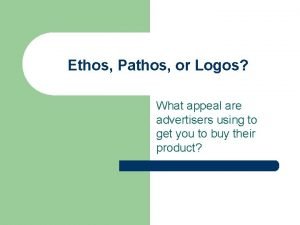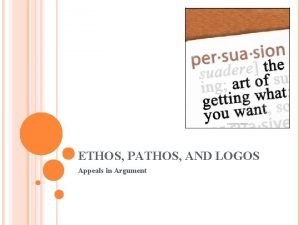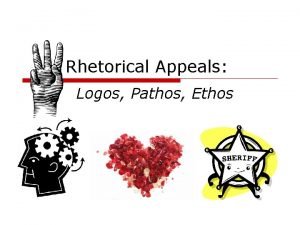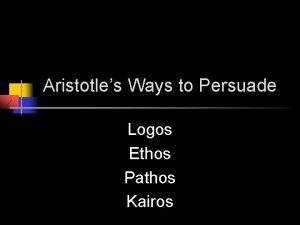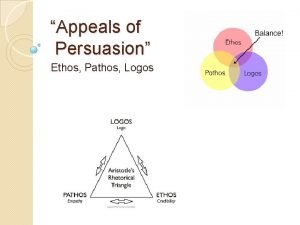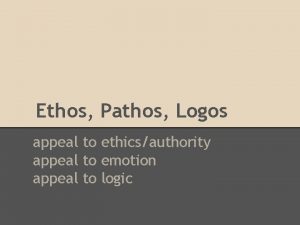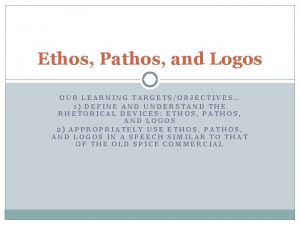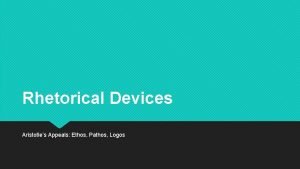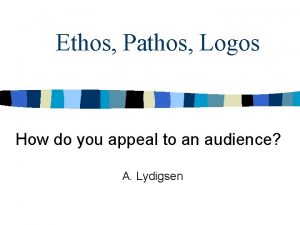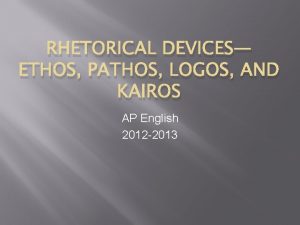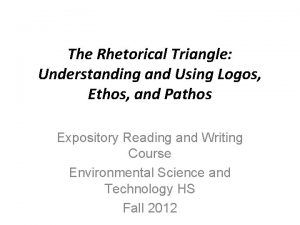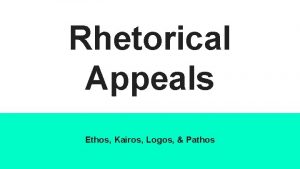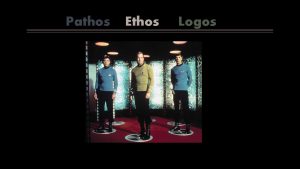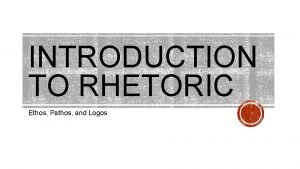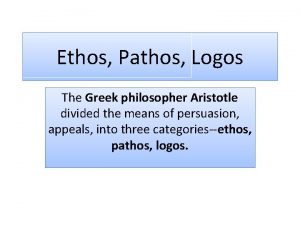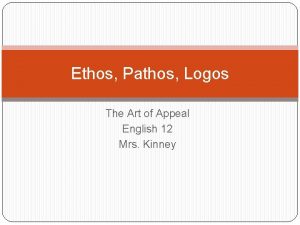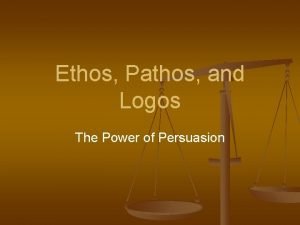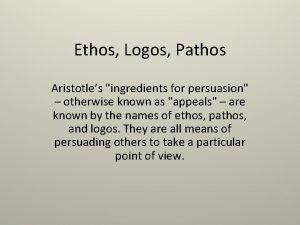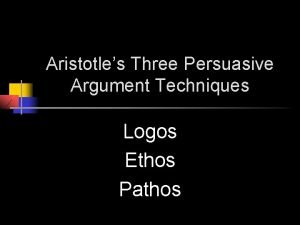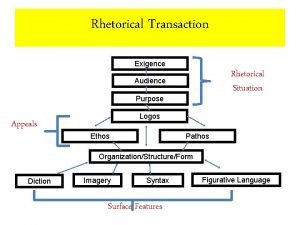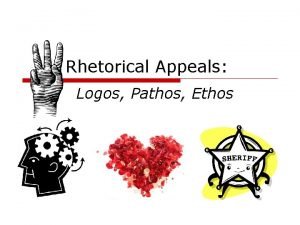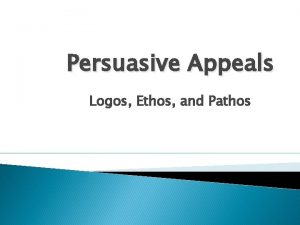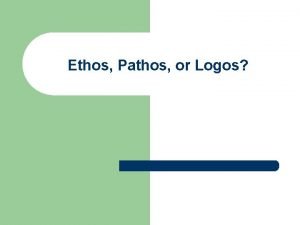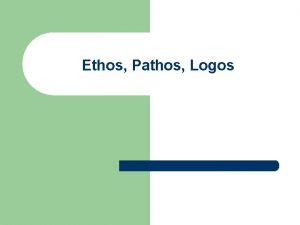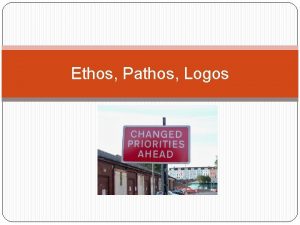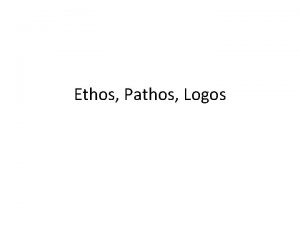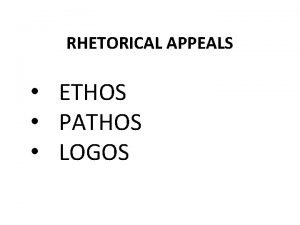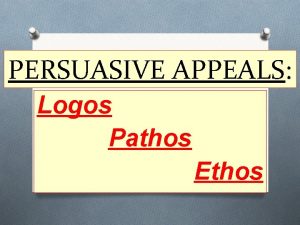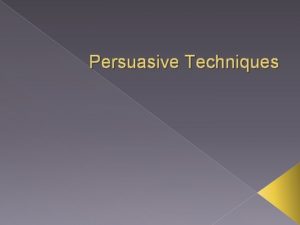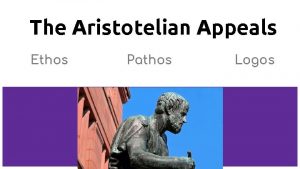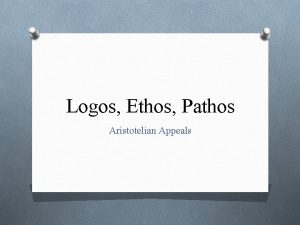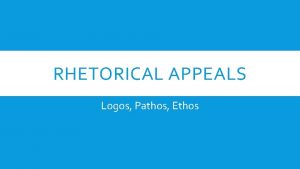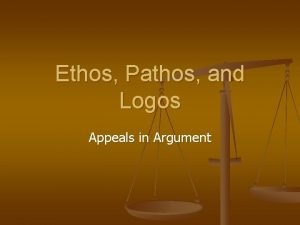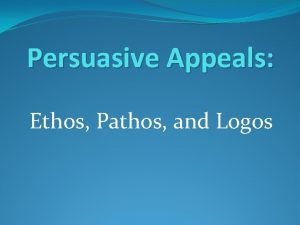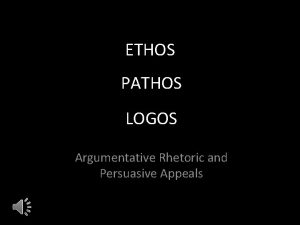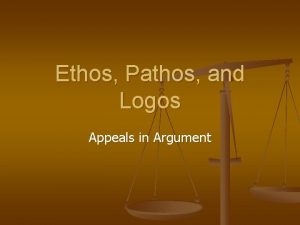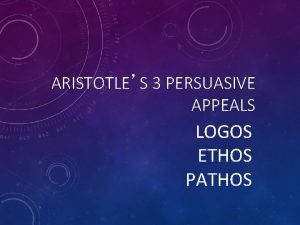PERSUASIVE TECHNIQUES Appeals ethos logos and pathos Techniques


![ARISTOTLE [384 B. C. TO 322 B. C] Greek philosopher Student of Plato and ARISTOTLE [384 B. C. TO 322 B. C] Greek philosopher Student of Plato and](https://slidetodoc.com/presentation_image/3916dd6cf347aea00d7508a36a7db908/image-3.jpg)

![ETHOS [ETHICS/AUTHORITY] A person is influenced by the writer’s image or character Aristotle called ETHOS [ETHICS/AUTHORITY] A person is influenced by the writer’s image or character Aristotle called](https://slidetodoc.com/presentation_image/3916dd6cf347aea00d7508a36a7db908/image-5.jpg)
![LOGOS [LOGIC] An argument based on reason Aristotle saw it as the basic ability LOGOS [LOGIC] An argument based on reason Aristotle saw it as the basic ability](https://slidetodoc.com/presentation_image/3916dd6cf347aea00d7508a36a7db908/image-6.jpg)
![PATHOS [PASSION] Use of emotional appeals to get the audience to accept the speaker’s PATHOS [PASSION] Use of emotional appeals to get the audience to accept the speaker’s](https://slidetodoc.com/presentation_image/3916dd6cf347aea00d7508a36a7db908/image-7.jpg)





























- Slides: 36

PERSUASIVE TECHNIQUES Appeals (ethos, logos, and pathos) Techniques & Examples Exercises

BASIC PRINCIPLES In this section, you’ll learn about: v. Appeal to Ethics/Morals (ethos) v. Appeal to Logic (logos) v. Appeal to Emotion (pathos)
![ARISTOTLE 384 B C TO 322 B C Greek philosopher Student of Plato and ARISTOTLE [384 B. C. TO 322 B. C] Greek philosopher Student of Plato and](https://slidetodoc.com/presentation_image/3916dd6cf347aea00d7508a36a7db908/image-3.jpg)
ARISTOTLE [384 B. C. TO 322 B. C] Greek philosopher Student of Plato and the teacher of Alexander the Great Wrote about subjects including poetry, government, ethics, biology, physics and more Aristotle identified three techniques one could use when trying to persuade someone: Ethos Logos Pathos

![ETHOS ETHICSAUTHORITY A person is influenced by the writers image or character Aristotle called ETHOS [ETHICS/AUTHORITY] A person is influenced by the writer’s image or character Aristotle called](https://slidetodoc.com/presentation_image/3916dd6cf347aea00d7508a36a7db908/image-5.jpg)
ETHOS [ETHICS/AUTHORITY] A person is influenced by the writer’s image or character Aristotle called it the “moral rightness” of an argument. Aristotle said that we are more likely to believe what the person has to say if s/he has “good sense, good moral character and goodwill. ” Arguments using “authority. ”
![LOGOS LOGIC An argument based on reason Aristotle saw it as the basic ability LOGOS [LOGIC] An argument based on reason Aristotle saw it as the basic ability](https://slidetodoc.com/presentation_image/3916dd6cf347aea00d7508a36a7db908/image-6.jpg)
LOGOS [LOGIC] An argument based on reason Aristotle saw it as the basic ability to create logical arguments and to persuade someone that your ideas and solutions are true
![PATHOS PASSION Use of emotional appeals to get the audience to accept the speakers PATHOS [PASSION] Use of emotional appeals to get the audience to accept the speaker’s](https://slidetodoc.com/presentation_image/3916dd6cf347aea00d7508a36a7db908/image-7.jpg)
PATHOS [PASSION] Use of emotional appeals to get the audience to accept the speaker’s viewpoint A common use of pathos in argument is to make the audience “feel bad” or “rejected” if they fail to agree with the speaker’s argument.

PERSUASIVE TECHNIQUES AND STRATEGIES Part 1

APPEAL TO AUTHORITY/EXPERT OPINION Calls on an expert to provide credibility or importance to product, service or position For example: Dentist promotes a certain brand of toothpaste “Four out of five dentists recommend sugarless gum for their patients who chew gum”

APPEAL TO EMOTION Uses emotionally charged language or images For example: Humane Society commercials Humane Society Commercial Pictures of devastation caused by natural disasters in order to boost support for relief efforts Red Cross Commercial

APPEAL TO ETHICS Positions the writer or speaker as a person of good sense, good moral character and good intentions For example: A political candidate says he refuses to mud-sling and prefers to talk about the issues instead

APPEAL TO LOGIC Provides rational arguments to support one’s claim using facts, figures and statistics For example: Facts are given that support the need to reduce traffic fatalities

YOUR TURN! Smoking is dangerous because cigarette smoke contains over 4, 800 chemicals, 69 of which are known to cause cancer. Logic There is clear evidence that cell phones save lives in emergency situations. Emotion My dentist says that I should brush and floss twice daily to help take care of my teeth. Authority

YOUR TURN! –FACEBOOK-THEMED Lady Gaga was more popular than Justin Bieber in 2011 because she had ten million more Facebook fans than Bieber. Logic Facebook, used by millions of people including celebrities like Oprah and Bill Gates, is a reliable way to network. Authority Facebook is slowly eroding your sense of privacy and eventually, you will not mind being monitored without your knowledge. Emotion The ability to express yourself freely on Facebook is a right guaranteed by the Constitution. Ethics

YOUR TURN! –UNIFORM-THEMED We should do away with our uniform because it limits our development of self-expression. Ethics A study by the Department of Education showed that student learning increased when the distraction of fashion was removed. Logic How would you feel if you had to wear the same clothes all the time? Emotion

CREATE YOUR OWN 1. With a partner, write one persuasive statement for each type of appeal. 2. When you finish, have another group try to identify the type of appeal you used.

PERSUASIVE TECHNIQUES AND STRATEGIES Part 2

BANDWAGON Attempts to persuade the consumer that something is good because “everyone” is doing it (“jumping on the bandwagon”). This appeals to our desire to be part of the group. For example: “Everyone is switching to this cell phone network. Shouldn’t you? ”

CARD STACKING Leaves out necessary information for the audience/consumer to make an informed decision “Stacks the cards” in favor of one’s viewpoint by using only arguments that support a position or by ignoring or denying the arguments against it For example: A newspaper uses a large picture of a smiling spokesperson for an organization that it favors or a less attractive or smaller picture of a person speaking on behalf of a position they do not support

RECENT “CARD STACKING”

ENDORSEMENT/TESTIMONIAL Uses a popular figure such as a celebrity to endorse a product, service or cause For example: Celebrities with beautiful complexions endorse Proactive

EXAGGERATION Overstates the effectiveness or importance of a product For example: An anti-wrinkle cream promises to take off 10 years in one night

EUPHEMISMS Substitutes an agreeable or inoffensive expression or term for one that may offend or suggest something unpleasant For example: The phrase “we are experiencing heavy casualties” to describe people dying What euphemisms can you think of for “dying”/ “died”?

FEAR Presents a dreaded circumstance and usually follows it up with the kind of behavior needed to avoid that horrible event For example: “This is your brain (image of an egg). This is your brain on drugs (image of the egg being cracked into a hot frying pan. )”

GLITTERING GENERALITIES Uses slogans or simple phrases that sound good but provide little or no information due to the vagueness of the message or the positive connotations of the words For example:

PLAIN-FOLKS APPEAL Works by suggesting that everyday things are superior to special or extravagant things For example: Country Time lemonade sells itself as simple and therefore valuable – a return to the “good old days” when plain folks and simple ways were important

REPETITION Repeats product, service or position several times For example: “Head On – apply directly to the forehead. ”

RHETORICAL QUESTIONS Asks a question in which no response is expected or desired (the answer is obvious). The question is used for effect or is used to emphasize a point For example: “Can we continue to allow our troops to die? ”

SELECTIVE CONNOTATION / WORD CHOICE Chooses words that will influence audience’s perception of an item or issue For example: “The assignment was asinine. ” vs. “The assignment was irksome”

SEX APPEAL/ BEAUTIFUL PEOPLE Uses beautiful and attractive people to sell you something For example: A handsome man promotes using a Gillette razor What is the subconscious suggestion? A beautiful woman standing next to a sports car What is the subconscious suggestion A pair of beautiful people working out with a new piece of exercise equipment What is the subconscious suggestion? A ruggedly handsome man, hard at work, he has a big truck, a beard, muscles, and is holding a tin of chewing tobacco What is the subconscious suggestion?

SCIENTIFIC APPROACH Uses tests, statistics and scientific sounding jargon or diagrams to lend credibility to something For example: A chair is ergonomically designed to fit the contours of your body Any of those “shape up” sneakers This diet pill has a proven formula that “our lab’s tests” show a dramatic loss in belly fat as compared to other products.

SNOB APPEAL Plays on our desire for fancy items and the “good life” For example: Commercial shows a crystal bowl as a cat is called to a Fancy Feast dinner “Choosy moms choose JIF. ”

SOMETHING FOR NOTHING Belief that most people are seeking a “good buy” or “something for nothing” For example “If you buy this computer, we’ll throw in a free printer” Buy one, get one ½ off

TRANSFER Uses words, images or symbols that arouse emotions and connect the viewer’s emotion to the product being sold For example: A tire dealer places red, white and blue banners throughout his store, or a political activist closes his speech with a prayer

URGENCY / CALL TO ACTION Creates the impression that you have to act fast For example “Order now! Supplies are limited! Everything must go!”

YOUR TASK Find one example of an advertisement using one of these techniques. Write a brief description of the advertisement. Identify the persuasive technique being used. Explain if the technique is an appeal to Ethos, Pathos, or Logos. Explain why you think it is so.
 Appeals ethos pathos logos
Appeals ethos pathos logos Appeals ethos pathos logos
Appeals ethos pathos logos What greek philosopher named the appeals ethos pathos logos
What greek philosopher named the appeals ethos pathos logos Famous speeches with ethos pathos and logos
Famous speeches with ethos pathos and logos Ethos, pathos, logos examples
Ethos, pathos, logos examples Rhetoric ethos pathos logos kairos
Rhetoric ethos pathos logos kairos Ethos rhetoric
Ethos rhetoric Ethos pathos logos
Ethos pathos logos Define ethos pathos and logos
Define ethos pathos and logos Pathos ethos logos kairos
Pathos ethos logos kairos Ethos logos pathos def
Ethos logos pathos def Ethos definition
Ethos definition Logos ethos pathos
Logos ethos pathos Ethos, pathos, logos, kairos
Ethos, pathos, logos, kairos Logos ethos pathos triangle
Logos ethos pathos triangle Logos ethos pathos triangle
Logos ethos pathos triangle Rhetorical devices for logos
Rhetorical devices for logos Pathos ethos logos kairos
Pathos ethos logos kairos Ethos pathos logos in fahrenheit 451
Ethos pathos logos in fahrenheit 451 Logos rhetoric definition
Logos rhetoric definition Ethos, pathos, logos greek
Ethos, pathos, logos greek Logos appeal
Logos appeal Pathos emotions
Pathos emotions Are ethos and pathos logical fallacies
Are ethos and pathos logical fallacies Ethos speech definition
Ethos speech definition Ethos pathos logos examples
Ethos pathos logos examples Ethos in the crucible
Ethos in the crucible Logos ethos, pathos
Logos ethos, pathos Patos
Patos Ethos pathos logos kairos
Ethos pathos logos kairos Ethos pathos logos quiz
Ethos pathos logos quiz Exigence purpose audience
Exigence purpose audience Rhetorical devices for logos
Rhetorical devices for logos Rhetorical devices kahoot
Rhetorical devices kahoot Ethos, pathos, logos
Ethos, pathos, logos Logos advertisement
Logos advertisement Ethos, pathos logos worksheet doc
Ethos, pathos logos worksheet doc
